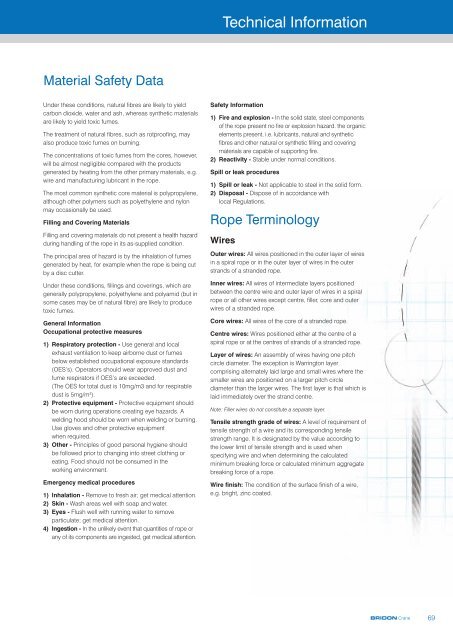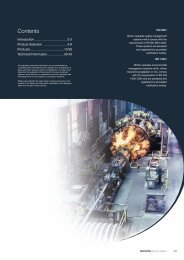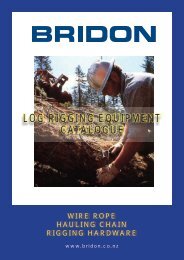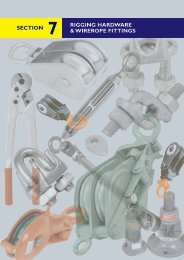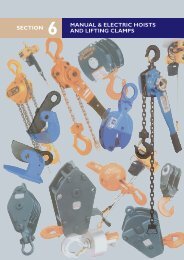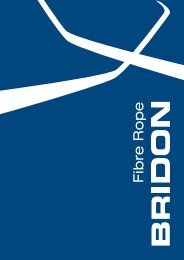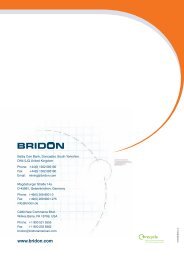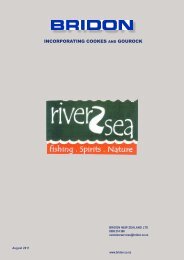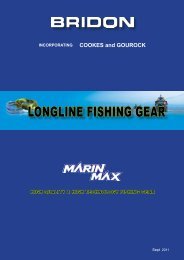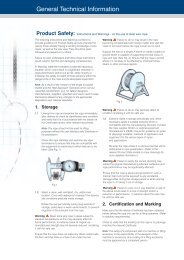Technical InformationMaterial <strong>Safety</strong> DataUnder these conditions, natural fibres are likely to yieldcarbon dioxide, water and ash, whereas synthetic materialsare likely to yield toxic fumes.The treatment of natural fibres, such as rotproofing, mayalso produce toxic fumes on burning.The concentrations of toxic fumes from the cores, however,will be almost negligible compared with the productsgenerated by heating from the other primary materials, e.g.wire and manufacturing lubricant in the rope.The most common synthetic core material is polypropylene,although other polymers such as polyethylene and nylonmay occasionally be used.Filling and Covering MaterialsFilling and covering materials do not present a health hazardduring handling of the rope in its as-supplied condition.The principal area of hazard is by the inhalation of fumesgenerated by heat, for example when the rope is being cutby a disc cutter.Under these conditions, fillings and coverings, which aregenerally polypropylene, polyethylene and polyamid (but insome cases may be of natural fibre) are likely to producetoxic fumes.General InformationOccupational protective measures1) Respiratory protection - Use general and localexhaust ventilation to keep airborne dust or fumesbelow established occupational exposure standards(OES’s). Operators should wear approved dust andfume respirators if OES’s are exceeded.(The OES for total dust is 10mg/m3 and for respirabledust is 5mg/m 3 ).2) Protective equipment - Protective equipment shouldbe worn during operations creating eye hazards. Awelding hood should be worn when welding or burning.Use gloves and other protective equipmentwhen required.3) Other - Principles of good personal hygiene shouldbe followed prior to changing into street clothing oreating. Food should not be consumed in theworking environment.Emergency medical procedures1) Inhalation - Remove to fresh air; get medical attention.2) Skin - Wash areas well with soap and water.3) Eyes - Flush well with running water to removeparticulate; get medical attention.4) Ingestion - In the unlikely event that quantities of rope orany of its components are ingested, get medical attention.<strong>Safety</strong> Information1) Fire and explosion - In the solid state, steel componentsof the rope present no fire or explosion hazard. the organicelements present, i.e. lubricants, natural and syntheticfibres and other natural or synthetic filling and coveringmaterials are capable of supporting fire.2) Reactivity - Stable under normal conditions.Spill or leak procedures1) Spill or leak - Not applicable to steel in the solid form.2) Disposal - Dispose of in accordance withlocal Regulations.Rope TerminologyWiresOuter wires: All wires positioned in the outer layer of wiresin a spiral rope or in the outer layer of wires in the outerstrands of a stranded rope.Inner wires: All wires of intermediate layers positionedbetween the centre wire and outer layer of wires in a spiralrope or all other wires except centre, filler, core and outerwires of a stranded rope.Core wires: All wires of the core of a stranded rope.Centre wires: Wires positioned either at the centre of aspiral rope or at the centres of strands of a stranded rope.Layer of wires: An assembly of wires having one pitchcircle diameter. The exception is Warrington layercomprising alternately laid large and small wires where thesmaller wires are positioned on a larger pitch circlediameter than the larger wires. The first layer is that which islaid immediately over the strand centre.Note: Filler wires do not constitute a separate layer.Tensile strength grade of wires: A level of requirement oftensile strength of a wire and its corresponding tensilestrength range. It is designated by the value according tothe lower limit of tensile strength and is used whenspecifying wire and when determining the calculatedminimum breaking force or calculated minimum aggregatebreaking force of a rope.Wire finish: The condition of the surface finish of a wire,e.g. bright, zinc coated.BRIDON Crane69
Technical InformationRope TerminologyStrandsStrand: An element of rope usually consisting of anassembly of wires of appropriate shape and dimensionslaid helically in the same direction in one or more layersaround a centre.Note: Strands containing three or four wires in the first layer or certainshaped (e.g. ribbon) strands may not have a centre.Round strand: A strand with a cross-section which isapproximately the shape of a circle.Triangular strand: A strand with a cross-section which isapproximately the shape of a triangle.Note: Triangular strands may have built-up centres (i.e. more thanone wire forming a triangle).Oval strand: A strand with a cross-section which isapproximately the shape of an ovalFlat ribbon strand: A strand without a centre wire with across-section which is approximately the shape of arectangle.Compacted strand: A strand which has been subjected toa compacting process such as drawing, rolling or swagingwhereby the metallic cross-sectional area of the wiresremains unaltered and the shape of the wires and thedimensions of the strand are modified.Note: <strong>Bridon</strong>’s brands of Dyform rope contain strands which havebeen compacted.Single lay strand: Strand which contains only one layer ofwires, e.g. 6-1.Parallel lay strand: Strand which contains at least twolayers of wires, all of which are laid in one operation (in thesame direction), e.g. 9-9-1; 12-6F-6-1; 14-7+7-7-1. Eachlayer of wires lies in the interstices of the underlying layersuch that they are parallel to one another, resulting inlinear contact.Note: This is also referred to as equal lay. The lay length of all thewire layers are equal.Seale: Parallel lay strand construction with the samenumber of wires in each wire layer, each wire layercontaining wires of the same size, e.g. 7-7-1; 8-8-1; 9-9-1.Warrington: Parallel lay strand construction having anouter layer of wires containing alternately large and smallwires, the number of wires in the outer layer being twicethat in the underlying layer of wires, e.g. 6+6-6-1; 7+7-7-1.Filler: Parallel lay strand construction having an outer layerof wires containing twice the number of wires than in theinner layer with filler wires laid in the intersticeswires of theunderlying layer of wires, e.g. 12-6F-6-1; 14-7F-7-1.Combined parallel lay: Parallel lay strand constructionhaving three or more layers of wires, e.g. 14-7+7-7-1;16-8+8-8-1; 14-14-7F-7-1; 16-16-8F+8-1.Note: The first two examples above are also referred to asWarrington-Seale construction. The latter two examples are alsoreferred to as Seale-Filler contruction.Multiple operation lay strand: Strand constructioncontaining at least two layers of wires, at least one of whichis laid in a separate operation. All of the wires are laid in thesame direction.Cross-lay: Multiple operation strand construction in whichthe wires of superimposed wire layers cross over oneanother and make point contact, e.g. 12/6-1.Compound lay: Multiple operation strand which contains aminimum of three layers of wires, the outer layer of which islaid over a parallel lay centre, e.g. 16/6+6-6-1.RopesSpiral Rope: An assembly of two or more layers of shapedand/or round wires laid helically over a centre, usually asingle round wire. There are three categories of spiral rope,viz. spiral strand, half-locked coil and full-locked coil.Spiral Strand: An assembly of two or more layers of roundwires laid helically over a centre, usually a single roundwire.Half-locked Coil Rope: A spiral rope type having anouter layer of wires containing alternate half lock andround wires.Full-locked Coil Rope: A spiral rope type having an outerlayer of full lock wires.Stranded Rope: An assembly of several strands laidhelically in one or more layers around a core or centre.There are three categories of stranded rope, viz. singlelayer, multi-layer and parallel-closed.Single Layer Rope: Stranded rope consisting of one layerof strands laid helically over a core.Note: Stranded ropes consisting of three or four outer strands may,or may not, have a core. Some three and four strand single layerropes are designed to generate torque levels equivalent to thosegenerated by rotation-resistant and low rotation ropes.Rotation-resistant Rope: Stranded rope having no lessthan ten outer strands and comprising an assembly of atleast two layers of strands laid over a centre, the directionof lay of the outer strands being opposite (i.e. contra - lay)to that of the underlying layer of strands.Low Rotation Rope: Rotation resistant rope having atleast fifteen outer strands and comprising an assembly ofat least three layers of strands laid over a centre intwo operations.Note: this category of rotation resistant rope is constructed in such amanner that it displays little or no tendency to rotate, or if guided,generates little or no torque when loaded.70BRIDON Crane


